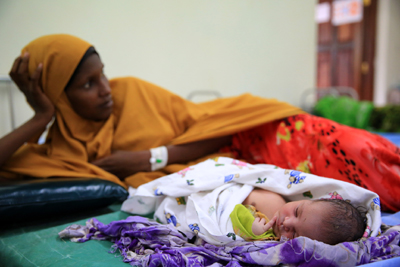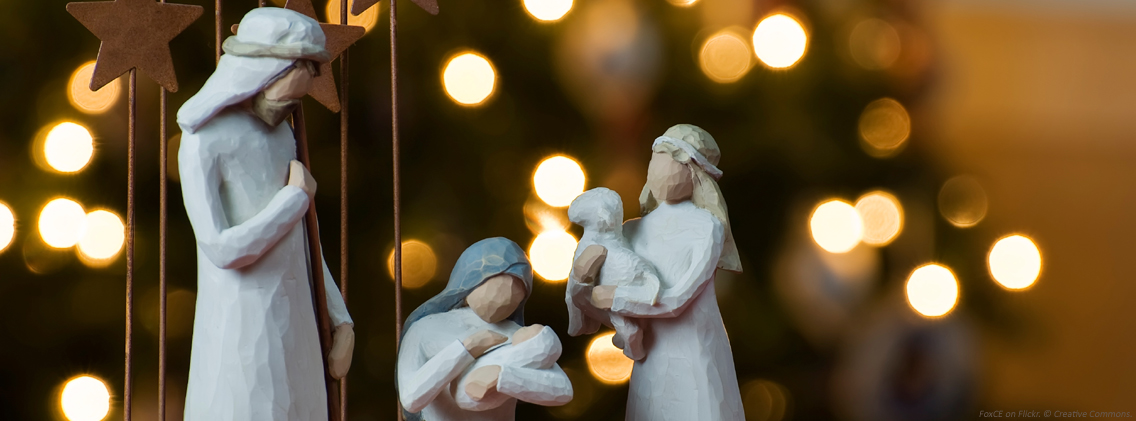Saugatuck Congregational Church, UCC
©Rev. Alison J. Buttrick Patton
December 24, 2015 – Christmas Reflection
A young Sudanese woman – maybe a teenager, maybe in her early twenties, lies on her side on a bare mattress, her elbow resting on a pillow. She is dressed in a mustard-colored wrap and head covering with a coral-colored skirt. Next to her lies a newborn baby, bundled in a teddy-bear print blanket. Boy or girl, I can’t say. His or her dark, curly hair is damp; eyes are closed; a finger brushes tiny lips. They are in a hospital in a refugee camp in Dadaab, Kenya. I do not know their story; the photograph and its caption are all I have to go on. Is the young mother content, apprehensive, relieved? Or all three?
 I found the photograph by running a search on Refugee mother and child. Because I wanted to see what Mary and Jesus might look like, were they making their journey with Joseph in 2016. Where would Mary give birth, if not in a stable? – In a tent on the beach, on the island of Lesbos, mountains of abandoned lifejackets piled just outside the tent entrance; or in a refugee camp in Jordan, in one of the hundreds of identical white temporary shelters, erected shoulder to shoulder – like so many sentries in the Jordanian desert? What is it like to deliver a baby under conditions such as these?
I found the photograph by running a search on Refugee mother and child. Because I wanted to see what Mary and Jesus might look like, were they making their journey with Joseph in 2016. Where would Mary give birth, if not in a stable? – In a tent on the beach, on the island of Lesbos, mountains of abandoned lifejackets piled just outside the tent entrance; or in a refugee camp in Jordan, in one of the hundreds of identical white temporary shelters, erected shoulder to shoulder – like so many sentries in the Jordanian desert? What is it like to deliver a baby under conditions such as these?
Pictures of the baby Jesus lying in a manger have become so ubiquitous that they’ve turned sentimental: a sweet child lying in sweet smelling straw, admired by docile animals and two adoring parents. We’ve lost the shock of it, the raw precariousness of a family forced to give birth in a barn after a long journey, on foot. Was there a midwife in town, or did Mary and Joseph go it alone? Was there fresh water? Or provisions to restore Mary’s strength after the delivery?
By setting the scene of Jesus’ birth in a barn (which was likely a shallow cave in that part of the world), God makes an already fleshy story even more so. There’s no sanitizing the scene, no hiding the blood, the afterbirth, the cries of a laboring woman. The sounds and smells of labor would have been carried on the wind. Stars and farm animals bore witness. God came into the world utterly exposed. Right from the start, Emmanuel announced that his life would be neither sheltered nor settled.
Ironic, then, that our culture so often associates Christmas with homecoming. “I’ll be home for Christmas” pines the popular ballad. We conjure up images of a hearth adorned with stockings, a table well-laid, and family gathered around – everything lit by a warm glow. This may or may not be your reality. Many of us know that Christmas can just as easily feel lonely, barren or hollow. Still, the image of a cozy, settled Christmas persists. Maybe it captivates us because it’s the thing we most long for: home. A place where we will be wrapped in love and comfort. A place where we will feel safe and accepted, where we can breathe easy and dream big.
And the truth of it is: the world is full of people who don’t have a home like that: People with no safe place to stay; people who have a house, but no love to fill it; and people who had a home once, but who have been driven from it by war or violence. So it’s worth remembering, on this Christmas Eve, that this is the night God chose not to stay home. Instead, God emerged in the most exposed of places, in the most tenuous of circumstances… born beneath the stars, to a couple traveling far from home, surrounded by foul smelling shepherds and restless sheep. Before the end of the story, Mary and Joseph would themselves become refugees, forced to flee into Egypt to escape a jealous king determined to kill all the baby boys in the land.
When it comes to Bible stories, I believe the details matter. “Pay attention,” says the writer. Wandering shepherds were the first to hear the Good News. Magi from distant lands journeyed great distances to find the baby. In fact, everyone in the story is on the move. What then, does that tell us? That God is to be found among the unsettled and the displaced. That if we want to encounter Emmanuel, God in the flesh, we might look to those who are themselves displaced: the battered mother, the runaway teen, the refugee – all those who have risked much to follow a star – across town or across an ocean…driven by fear and hope and a yearning for home.
I am not suggesting that it’s wrong to gather at home with family and friends on Christmas. If that’s what awaits you tomorrow, then surely it is time to be treasured. But the Christmas story reminds us that we are not meant to remain at home. Christmas is not about coziness. It takes place out in the wild, wide-open spaces, among the wanderers. While that may feel like unsettling news, it is also the best kind of Good News. God is at large, traveling the highways and byways, setting up camp in war zones; warming Her hands with the homeless round a make-shift fire; standing on line for food in that refugee camp; giving comfort and hope to a young Sudanese woman, who suspects that her newborn child might just change the world for good.
This is the Good News that transforms lives: God-in-the-flesh is born this night.
Thanks be to God. Amen.


